NORTH WALES COAST RAILWAY:NOTICE BOARD
Rheilffordd arfordir gogledd Cymru: Hysbysfwrdd
15 February 2016
 Last issue
Last issue Archive
Archive Tweet
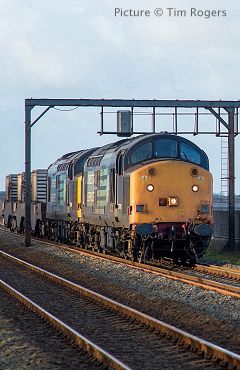
Tweets by @NWrail1
Contributions and comments are encouraged: see the Contributions Page
This list may be out of date if you are reading an archived issue. For full information visit our Calendar page.
February 2016
Friday 26 February Great Western Society NW Branch Group Annual Meeting, afterwards possibly Members slides.
March 2016
Friday 4 March Clwyd Railway Circle Annual General Meeting followed by: Dave Southern, A journey from Chester to Pwllheli in colour looking at the closed lines both standard and narrow gauge including closed steam sheds and some goods yards.
Tuesday 8 March North Wales Railway Circle 'Railways of Ontario' Chairman Brian Bollington shows a mix of slides and video he has taken of the railway scene in Ontario and Quebec, Canada. Including main lines, short lines, preserved lines with steam and museums. Due to Saint David's Day bookings this meeting has been arranged for the second Tuesday of the month.
Thursday 10 March Llandudno and Conwy Valley Railway Society Alan Roberts: Railway signalling in the Conwy/Llandudno area
Friday 11 March Altrincham Electric Railway Preservation Society "A Photographic Tribute to Alan Gilbert. Steam on the main line in the 1950s and 60s" a digital presentation by Paul Shackcloth.
Saturday 12 March Railway and Canal Historical Society North West Branch - The London & Dublin Railway: Surveys & Parliamentary Influences by Derek Cobby & Brian Dotson. Realisation of the inadequacy of the port of Holyhead and the increasing pressure for improvements coincided with the development of railways. Plans prepared for the Oxford, Worcester & Wolverhampton Railway included a route from Worcester to Porth Dinllaen on the Llyn Peninsula. Vignoles and Brunel favoured developing Porth Dinllaen route rather than Holyhead which would avoid crossing the Menai Straits. Vignoles direct route on standard gauge to connect with the Grand Junction Railway did not attract sufficient finance leaving Brunel's second broad gauge direct scheme as an alternative to
developing the route to Holyhead.
Monday 14 March Wrexham Railway Society, Railways Of Wales in the 1980's - Geoff Morris describes a trip through Wales in a decade during which livery variations started to appear and steam re-appeared on a scheduled basis along the Cambrian & North Wales Coasts.
Friday 25 March Great Western Society NW Branch Railway Images, Thirty Miles around Warrington, Barrie Rushton.
Monday 21 March RCTS: Railway Correspondence and Travel Society, Merseyside, Chester and North Wales Branch. "20 Years Of The Privatised Railway - What Does The Future Hold?" by Bob Casselden. Bob, a retired former B.R. manager looks at the changes to Britain's privatised railway over the last twenty years and reflects on what the future might bring.
April 2016
Friday 1 April Clwyd Railway Circle Denbigh Film Club. Railway Enthusiasts Film Night. A night of nostalgia and fun with a selection of films old and new to end our season in great style.
Tuesday 5 April North Wales Railway Circle 'All Steamed Up' Mr Barry Wynne presents a selection of his work from his vast catalogue of photographs.
Friday 8 April Altrincham Electric Railway Preservation Society "Steam in the North West of England and Scotland in 1965" a digital presentation by Noel Coates.
Saturday 9 April Railway and Canal Historical Society The Presidential Address: The LMS
School of Transport, Derby by Graham Wild. The speaker will tell the fascinating story of the school. The talk starts with the reason for the building and its location, moving on through a description of the building to the successful fight to save it and subsequent developments with what is now a
listed building.
Monday 11 April 2016 Wrexham Railway Society 'Days Gone' A Nostalgic Look Back at the 1960-90's by Larry Davies, looking at the enormous changes which have taken place on the railways in North Wales during the last four decades of the last century illustrated, mostly by Larry's own work.
Thursday 14 April Llandudno and Conwy Valley Railway Society 1960/70s North Wales Railway Recollection Barry Wynne/Steve Morris
Monday 18 April RCTS: Railway Correspondence and Travel Society, Merseyside, Chester and North Wales Branch. One Mans Rubbish is Another's Treasure by Russell Hatt. Russell presents a selection of historic railway photographs that whilst too poor for publication are of interest to the railway historian.
Friday 29 April Great Western Society NW Branch A tribute to Tom Lewis, Railway cameraman 1947-1970, Paul Shackcloth.
May 2016
Tuesday 3 May North Wales Railway Circle AGM and Photographic Competition.
Thursday 12 May Llandudno and Conwy Valley Railway Society Ray Bailey: Steam into Holywell
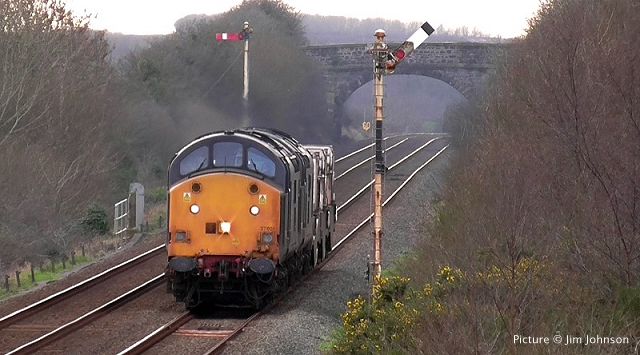
The Valley-Crewe flasks, powered by 37 601 Class 37 'Fifty' and 37 607, with three wagons, approaching Gaerwen at 14:33 on 3 February. Picture by Jim Johnson.
Almost caught up... hope you enjoy the show.- Charlie
The view from Queens Road bridge - pictures by Larry Davies
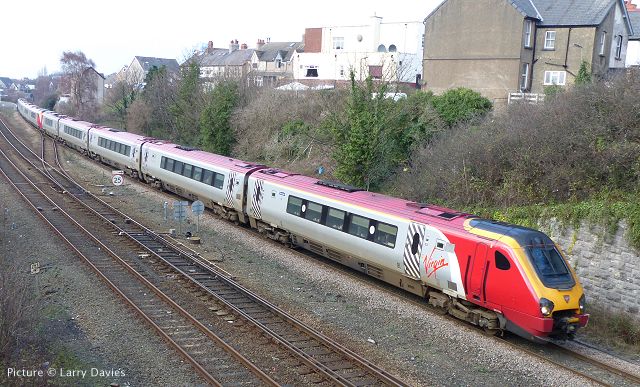
Like hundreds of enthusiasts have done over the years, Larry Davies spent some time watching the scene from the Queens Road bridge at Llandudno Junction. Here are three of his pictures from that interlude on 12 February. Above: double Voyagers 221 116 and 221 111 on the Up London head out of the station at 14:43.
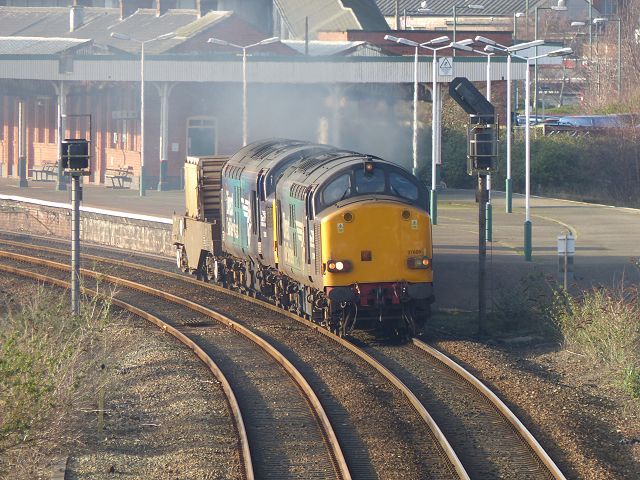
The 14.15 Valley - Crewe Flask train storms through the station with 37 609 and 37 069 in charge. The Queens Road bridge is an impressive stone structure carrying a very minor road. It is in fact an 'occupation bridge' which was required by the Act of Parliament on the building of the line, as a field belonging to the Glan-Morfa farmstead which stood on the site of the present-day caravan park was cut in two by the railway cutting. Queens Road, with its houses, was a later development.
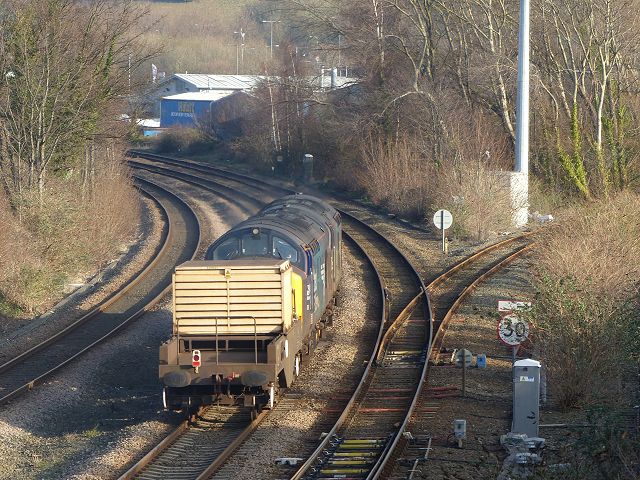
The same train passes the junction of the Conwy Valley line on which the rust bears witness to the absence of any traffic since before Christmas. Hopefully services will be back in the next two weeks.
If (or when) the North Wales line is ever electrified, the bridge parapet is likely to be raised to meet safety requirements, so photographers should makes the best of it now.
The Night Train Experience...
... is a short musical theatre performance designed especially for the Llandudno Junction-based Trakz organization by Anvil Productions - a talented company of actors and musical performers. It includes the 'Llandudno Junction song' apparently. This was put on last year and it was very popular, so here it again to kick off the Trakz season and get you in the mood for their main event on 7 May.
Venue: Llandudno Junction Community Club. Time: 17 February, 7pm. Price: Ł2 on the doors, proceeds to the Llandudno Junction Busking Festival.
Class 67 news compendium
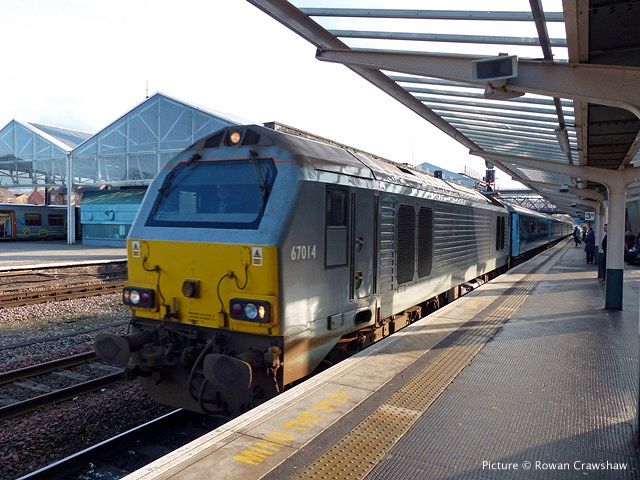
A round-up of February's Class 67 loco activities. Above, 67 014 - which had worked this diagram emery time since before the start of the year, at Chester with the 09:50 Manchester to Holyhead on 1 February (Rowan Crawshaw).
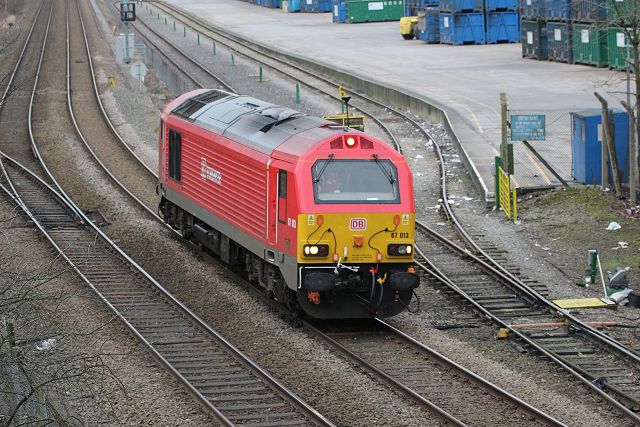
Brightening up the scene in its DB Schenker bright red at Northenden Junction on 2 February, 67 013, repainted from Wrexham & Shropshire / Chiltern silver. The turnout on the left is the single-line freight-only route towards Hazel Grove. On the right is Northenden refuse depot which dispatches trains to Runcorn Folly Lane (Greg Mape).
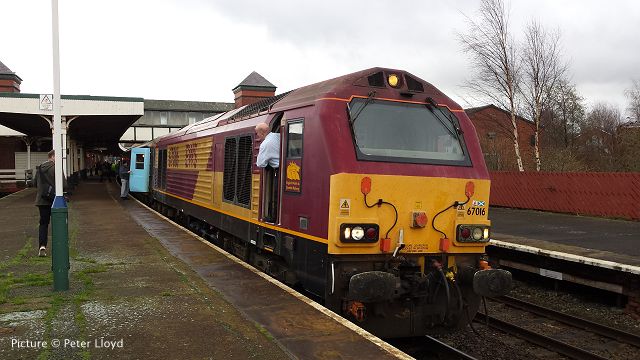
5 February saw a change of loco on the Manchester loco-hauled turn, with 67 016 taking over, as seen at Llandudno Junction with the 09:50 Manchester - Holyhead (Peter Lloyd). It's been suggested this loco had not been seen before on the North Wales Coast - but in fact it double-headed (with 67 003) a charter train to Holyhead on 7 October 2011 - for photographic evidence see our 17 October 2011 issue. Thanks to Richard Billingsley for setting us right on this.
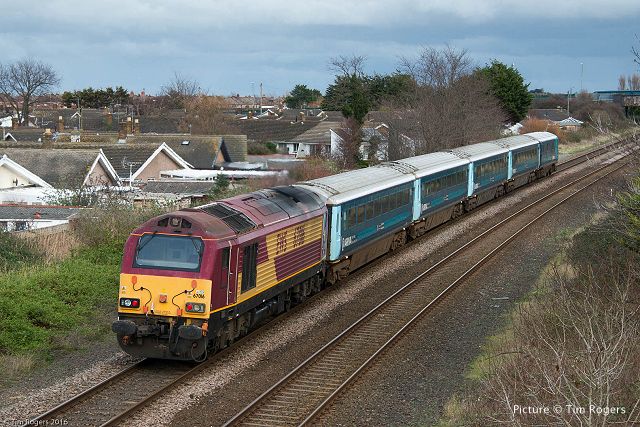
Propelling eastbound at Rhyl (Tim Rogers).
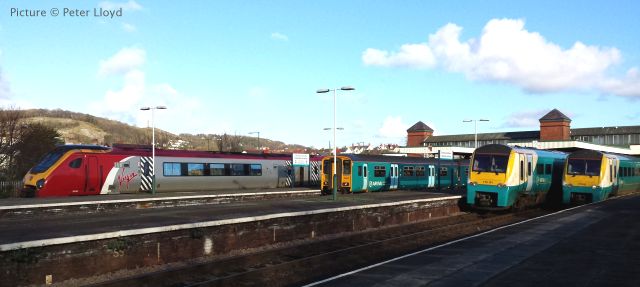
67 016 had a short career on the 'DfT service': on 10 February the 09:50 from Manchester was terminated at Llandudno Junction, suffering from dragging brakes, resulting in the cancellation of its return working, the 13:01 Holyhead - Manchester. It was decided to return 67 001 and its train empty the Crewe for attention, but it only reached Colwyn Bay before being sent back to Llandudno Junction, where trains were accumulating in the station (above, by Peter Lloyd.)
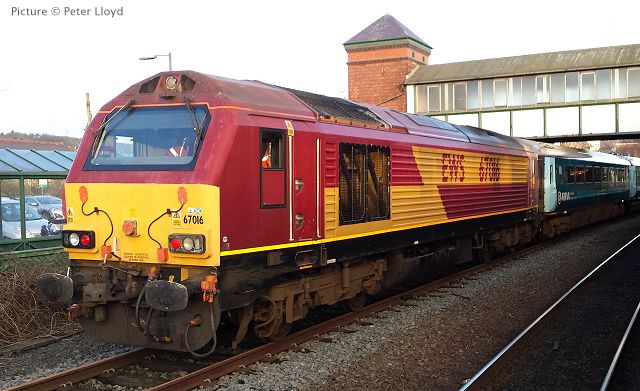
The errant train was then moved out of harm's way into the Tamper Siding (Peter Lloyd).
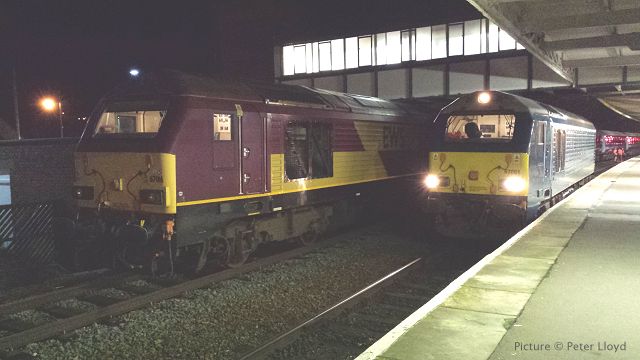
At 23:09, 67 001 appeared on the scene...
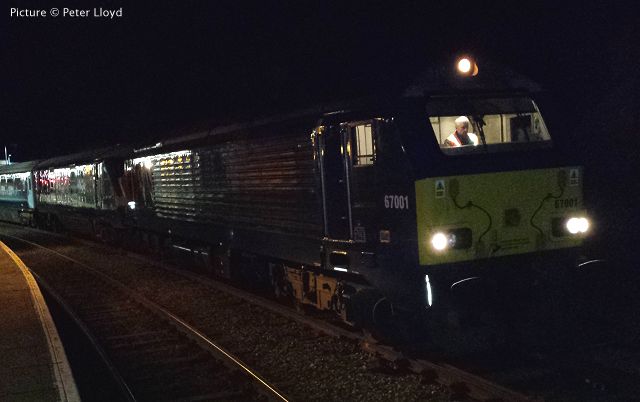
... and hauled the train with 67 016 safely to the train's base at Crewe, seen here departing from Llandudno Junction (Peter Lloyd).
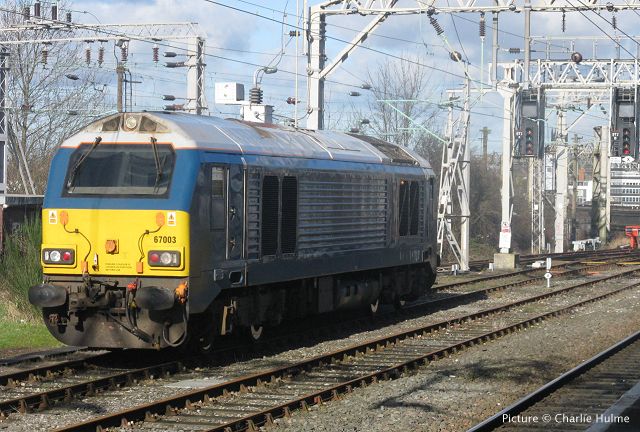
Elsewhere on 10 February, 67 003 was allocated to the route-learning run from Wigan to Wakefield which has been running in preparation for the new Knowsley - Wilton domestic refuse flow, which has mostly been worked by a Class 66. The loco is seen laying over at Stockport at mid-day awaiting a path, having run this far 130 minutes early (Charlie Hulme).
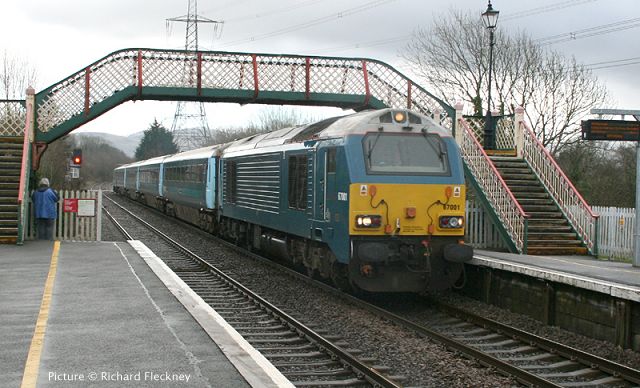
67 001 took over the Manchester diagram on 11 February, seen above heading west through Llanfair PG with the 09:50 from Manchester (Richard Fleckney).
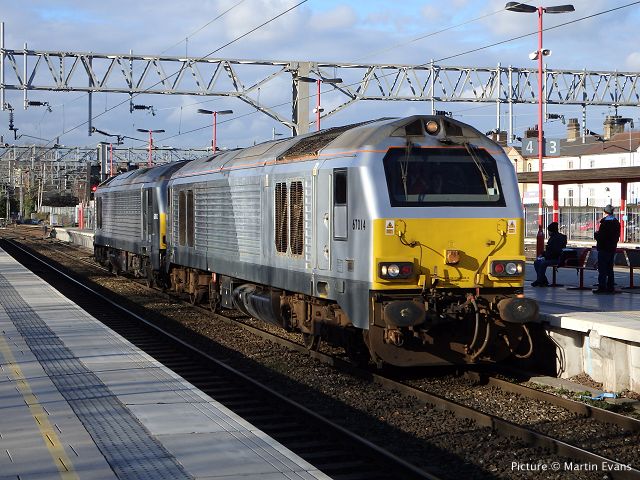
Still in silver, 67 014 and 67 012 seen at Stafford on the way from Crewe to Wembley on 11 February (Martin Evans).
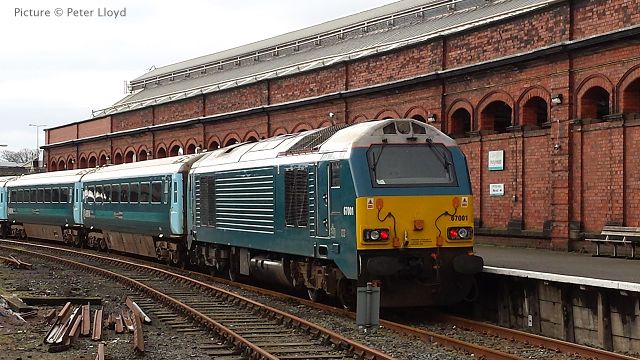
Friday 12 February, and 67 001 stands by Platform 3 at Holyhead after arrival with with 09:50 from Manchester (Peter Lloyd).
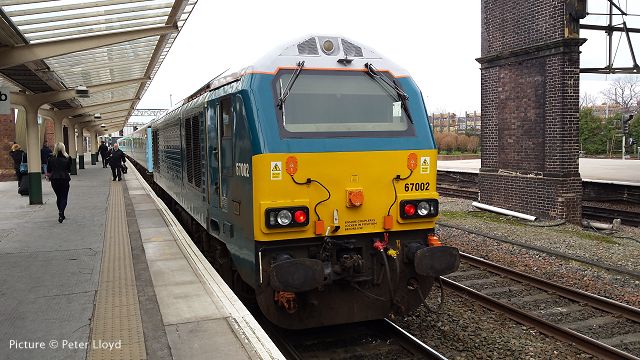
Saturday 13 February, and the Premier Express train was brought out to run train 1V90 Holyhead - Cardiff extra train for a Rugby match. Peter Lloyd photographed it at Chester, where the train reversed to head towards Wrexham.
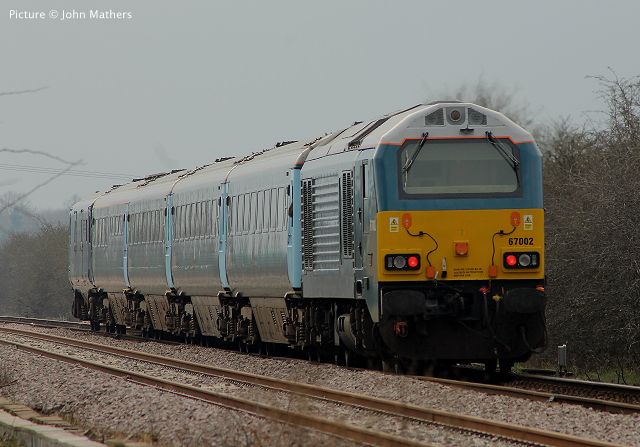
67 002 propelling the 'Ruggex' at Green Lane south of Saltney Junction on Saturday 13 February. Picture by John Mathers.
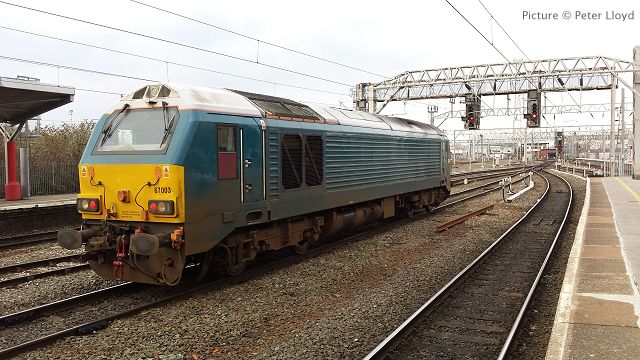
The third Arriva blue loco, 67 003, was captured by Peter Lloyd at Crewe on 13 February en route to the depot.
Infrastructure news
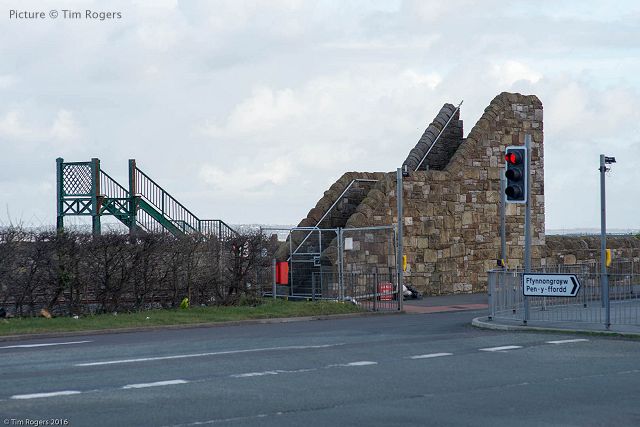
The strange sight of Mostyn footbridge minus its span, which has gone away to be refurbished, as has the one at Bagillt (Tim Rogers).
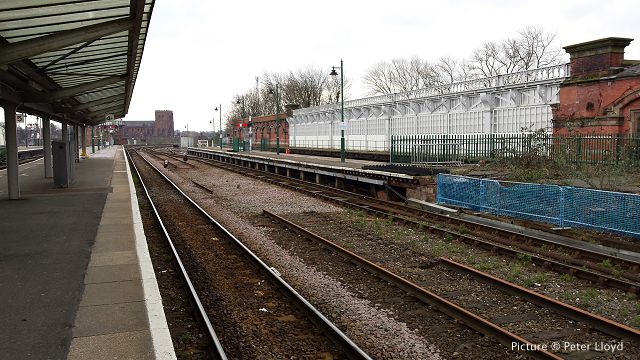
Missing track at Shrewsbury station. This part of the station is built on a bridge over the River Severn: are there safety concerns? Picture by Peter Lloyd.
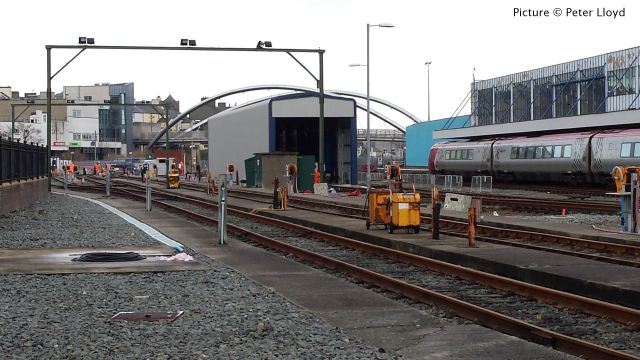
The new train washing plant at Holyhead is nearing completion (Peter Lloyd).
Half a 175
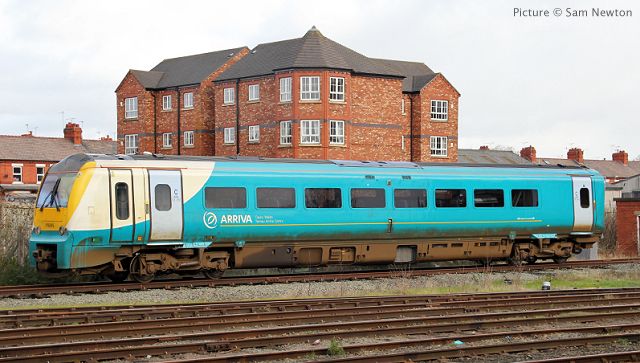
On the afternoon of 2 February at 13:50 Arriva Class 175 vehicle 79703 from 175 003 was sitting alone in siding 6 (furthest from platform 7) at Chester. Picture by Sam Newton, who writes : 'She wasn't there when I passed through Chester at 10:30 that morning so I assume she came out of the D.M.U.Depot around Tuesday lunchtime.'
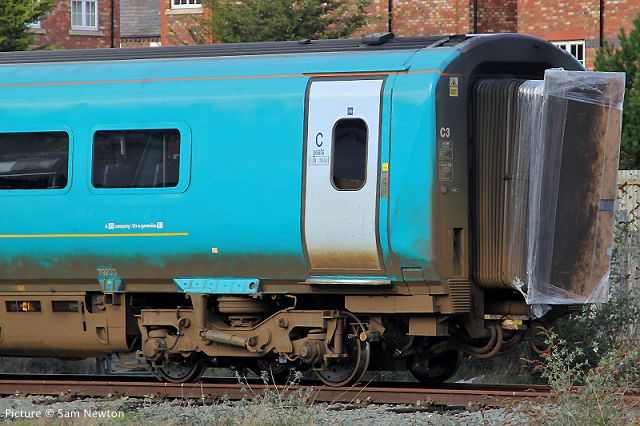
Another view showing plastic protection of the gangway connection. Why this vehicle was stabled here and where it's partner is we don't know (Sam Newton).
A few days later this vehicle was joined by 175 006, which has a damaged cab after an encounter with a fallen tree near Gobowen on 1 February. We recall from information on offer in the early days of the 175s that a replacement for the curved windscreen costs over Ł1000.
Llangollen Railway events - report by George Jones
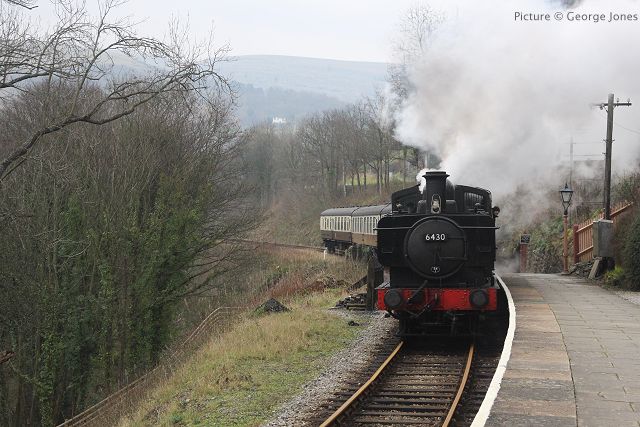
Train services at the Llangollen Railway have resumed on Saturday, 13 February for half-term week through to 21 February. Steam operates at the weekends: Pannier Tank 6430 worked the trains on 13 February, as seen here arriving at Berwyn ...
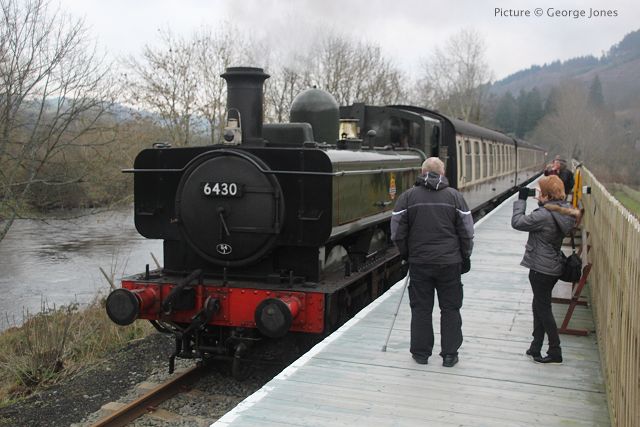
... and attracting attention at Corwen East. The weather was overcast but nevertheless, people were out to take in the journey through the Dee Valley in late winter when bare trees perhaps give the best views from the train. The Monday-Friday week service is with diesel railcars; there is no 'Thomas' event on these dates this year. Trains depart Llangollen at 10:40, 13:00 and 15:10 with returns from Corwen at: 11:20, 13:40 and 15:50.
Steam trains will run on 20-21 February, and services will resume for Easter from 14 March.
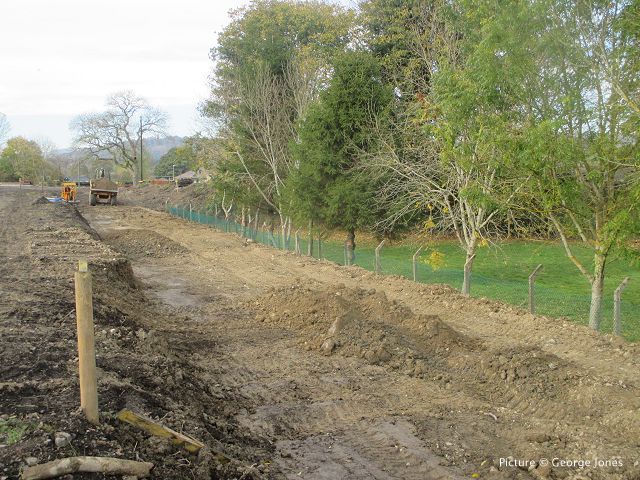
At Corwen arrangements for the local residents to inspect the Central station site were extended to allow LR members and supporters escorted access. Work to widen the embankment to provide for a run round loop and island platform was inspected.
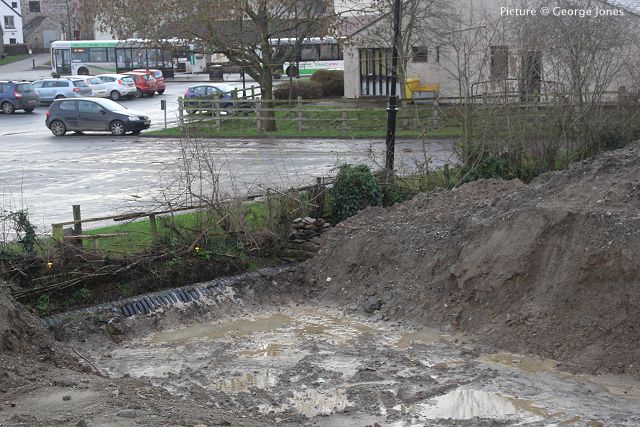
The excavation, which will allow for the installation of a subway and stairs to access the platform direct from the town's car park, was also examined, as were the arrangements to fill in the void at the former bridge 31 and the base for the installation of the signal box, as in store at Carrog, during the course of a detailed inspection of the site where the volunteer work force has made excellent progress with a minimum of resources.
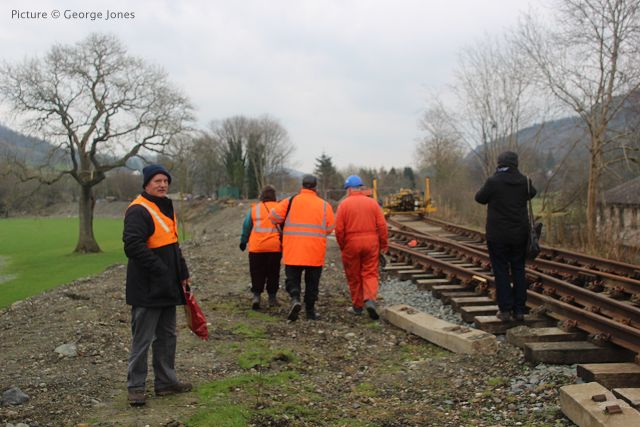
Track-work exists at the western end, pending the building of the island platform.
All that is needed to complete this important project is finance and to this end interest in and support for grant aid applications continues with supporters and VIPs encouraged to appreciate what is involved.
Locomotive Miscellany
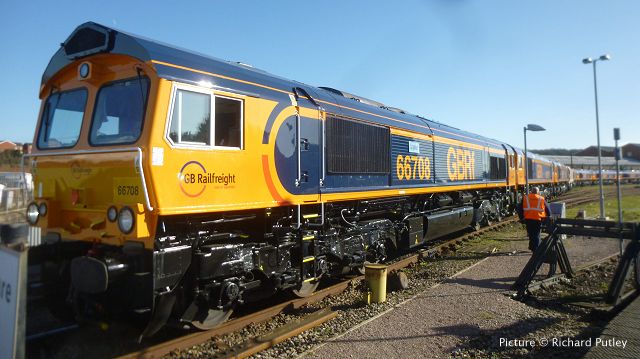
Thanks to a tip-off, Richard Putley was able to photograph a unique train hauled by very shiny-looking 66 708 Jayne: seven brand-new Class 66 locos just arrived from the USA for GB railfreight: 66 777, 66 776, 66 779 (sheeted over), 66 778, 66 774, 66 773, and 66 775. 66 779, which is said to be the very last Class 66 to be built, is sheeted over because its special livery is being kept secret. The Class 66 design cannot continue in production as it does not satisfy the latest emission regulations.
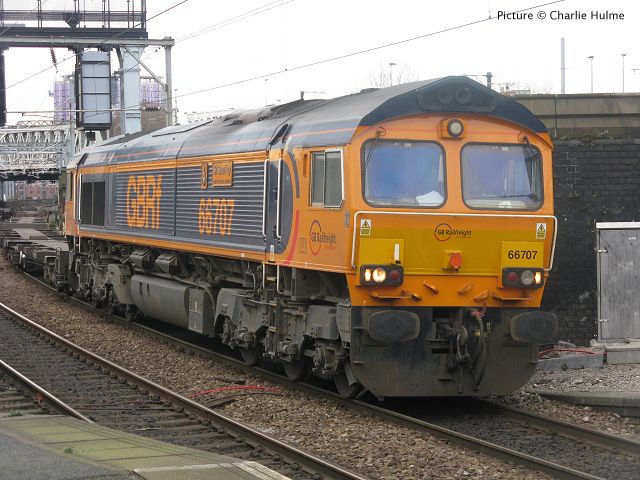
The 14:18 Trafford Park - Felixstowe is usually well-loaded with containers, but on 11 February the load was very sparse when seen passing Deansgate behind 66 707 Sir Sam Fay, Great Central Railway (Charlie Hulme).
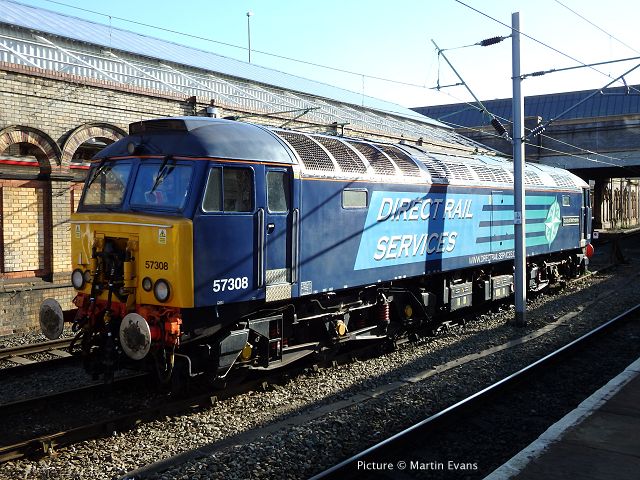
Two 'Thunderbirds' at Crewe on 11 February: 57 308 County of Staffordshire ...
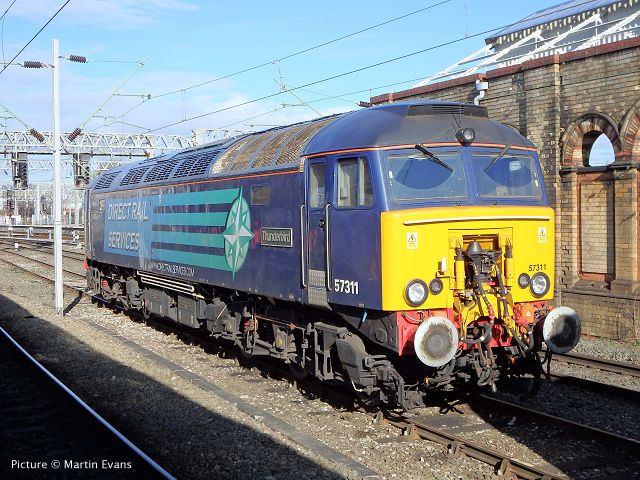
... and 57 311 Thunderbird (Martin Evans).
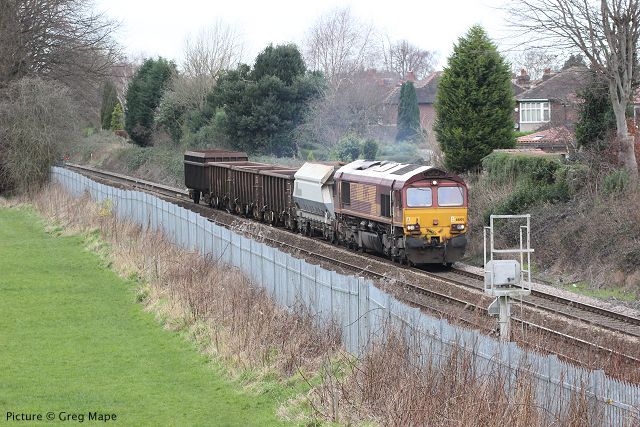
A freight train for the space-starved modeller: 66 105 seen from Stoney Bridge, Timperley with the Mondays-only trip working from Warrington Arpley yard to Peak Forest, composed as usual of repaired wagons.
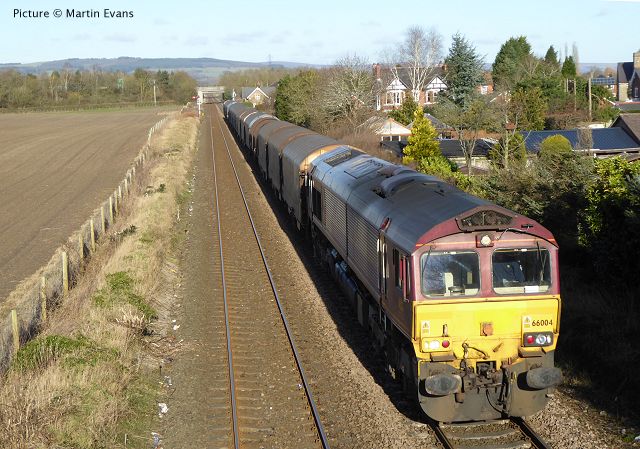
66 004 brings the steel wagons for Dee Marsh through Gobowen, 15 February. Picture by Martin Evans.
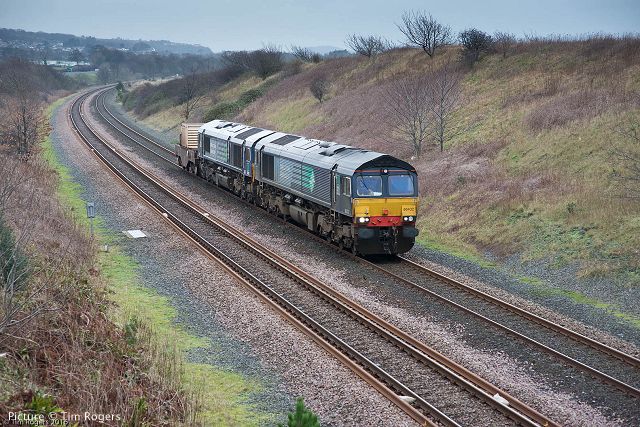
66 432, 66 303 and one flask wagon near Abergele on 5 February. Note the new rails which have been delivered to various locations on the Coast. In April the amazing Network Rail High-output Track Renewal train will be making nocturnal visits to remove the old track, clean the ballast, lay new sleepers, place the pre-delivered rails in position, and do all that's needed before trains can run again. It can re-lay 800 metres of track in a seven-hour overnight possession, says this interesting article.
47 853 in particular can claim to be a 'celebrity', having been chosen in 1964 as the 'XP64' loco which pioneered a first attempt at the BR rail blue livery, which it gained again many years later under Virgin Trains as Rail Express and retained when sold to Riviera Trains who in turn sold it to DRS. See the excellent Class 47 website for a fuller story.
Royal Scot reprised
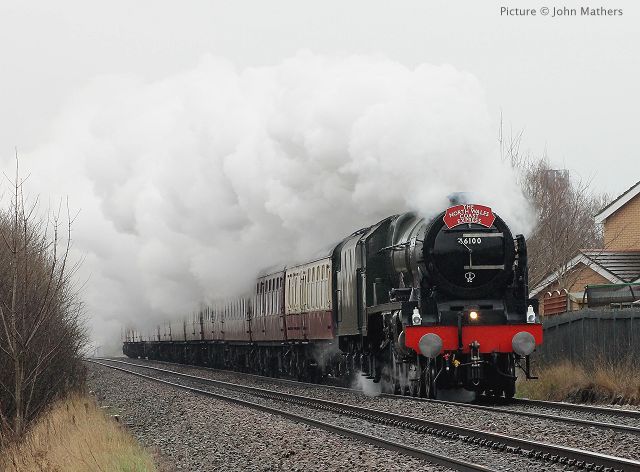
A quick second look at The North Wales Coast Express which ran to Holyhead on 6 February behind 46100 Royal Scot and was the subject of our recent special edition. John Mathers photographed the train at Shotton in the wet conditions which prevailed all day.
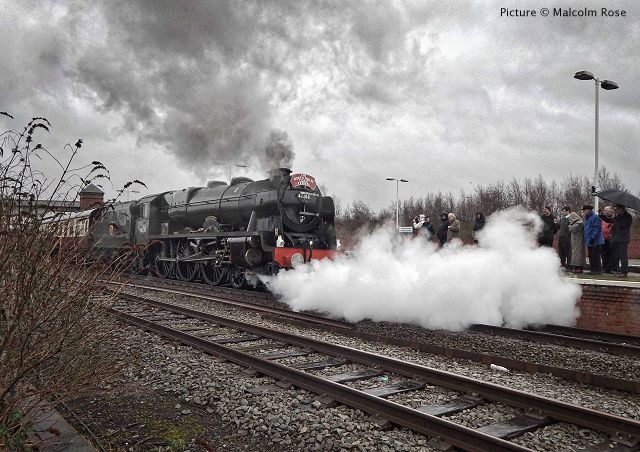
Llandudno Junction, from the Asda car park (Malcolm Rose)
We asked if 46100 had worked on the Coast in British Railways normal service, and several readers have assured us that it did so on a number of occasions. Huw Edwards writes: ' I know it was certainly in Holyhead in August 1957 when it hauled the 7.35 pm train towards Chester, because I was on the train.'
Penyffordd simplified
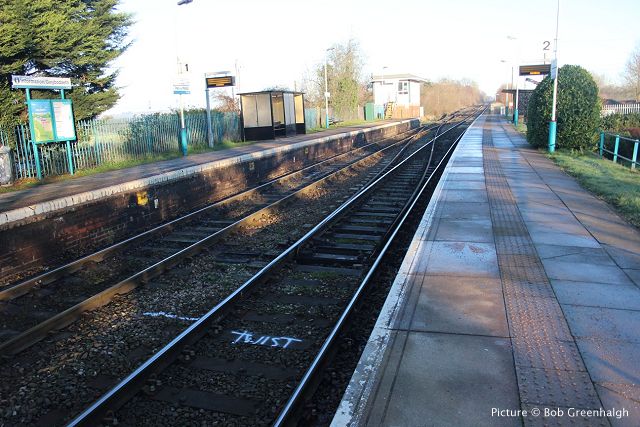
Delivery of some track materials to Penyffordd had led to speculation about improvements to handle the long-promised outgoing cement traffic from the nearby works as well as the present inward slow of coal. However, the only change so far has been the removal of the crossover alongside the signalbox. The picture above, by Bob Greenhalgh, shows the station layout as it was in January 2016.
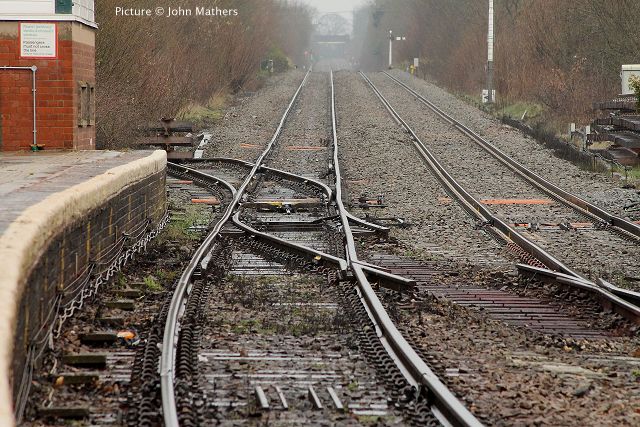
By Saturday 6 January, as much of the rails had been removed as could be accomplished without severing the main line. The telephoto view by John Mathers illustrates the 'switchback' nature of this route.
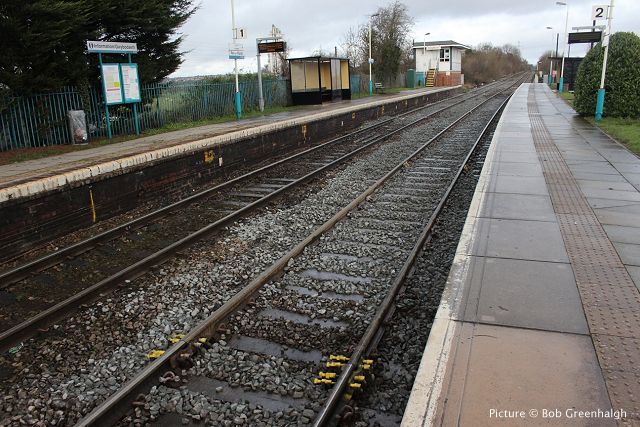
By the end of Sunday 7 February the remainder had replaced by 'plain line' and re-ballasted. (Bob Greenhalgh). Note the temporary rail joints using screw clamps and special fishplates; these will be replaced in due time by welded joints.
Great Central Steam Gala - report by Alan Crawshaw
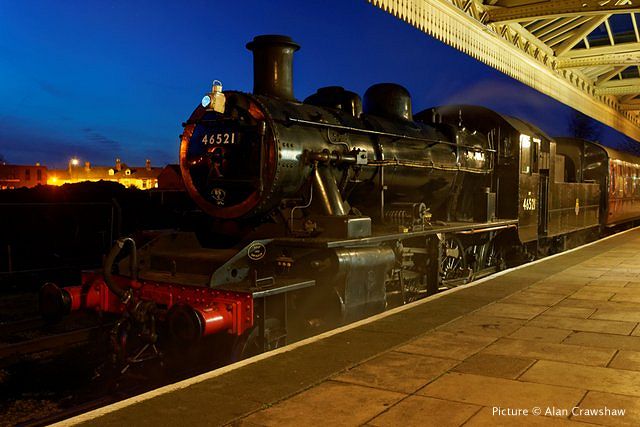
On Saturday 30 January, Rowan and I set off for the Great Central Railway's steam gala, beginning with the 08:22 Virgin service which was unusually lightly loaded. The next train was the only busy one of the day, dominated by football fans squeezing into 153 302 for the slow trundle to Derby. We transferred onto a Cardiff to Nottingham service which delivered us to Loughborough four hours after starting our journey at Bangor.
A brisk walk ensured we caught the 12:45 departure from the Great Central station, hauled by U class 31806, visiting from the Swanage Railway. The train was full and standing, as were all services until late afternoon, so we alighted at Rothley on the return to watch the action and take photographs. As most of the line is double track, there is scope for demonstration freight trains and the Travelling Post Office demonstration to run at frequent intervals without adversely affecting passenger services, a main line atmosphere unique on the British preserved scene.
Trains ran into the evening, affording the opportunity of a run in darkness but we set up our tripods at Loughborough. (above).
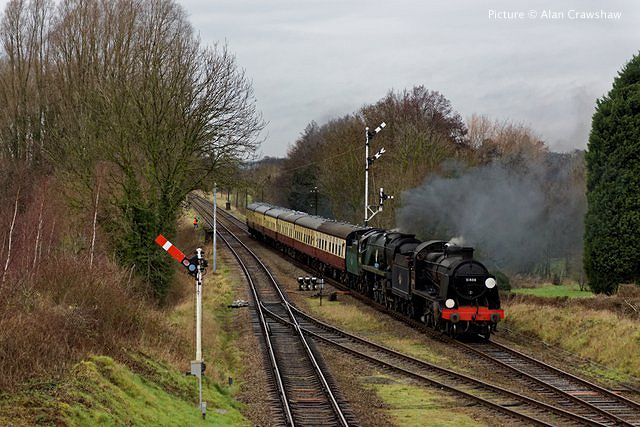
On Sunday morning we walked through the drizzle to catch the first train of the day. Later the weather improved and again the trains were very busy though not as crowded as Saturday. The road bridges over the line at the two intermediate stations are convenient for watching and photographing the action: these three pictures of the Southern double header (above) ...
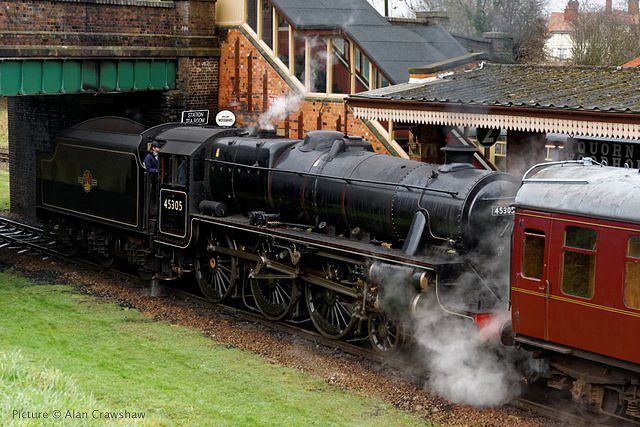
... the black 5 ...
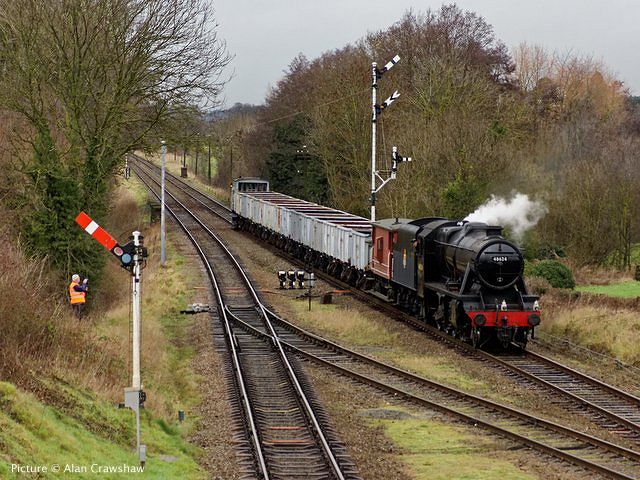
... and the 8F were taken in the space of 22 minutes at Quorn and Woodhouse station. A feature of this line is its 'windcutter' rake of 16-ton mineral wagons, many thousands of which once could be seen on the British Railways network.
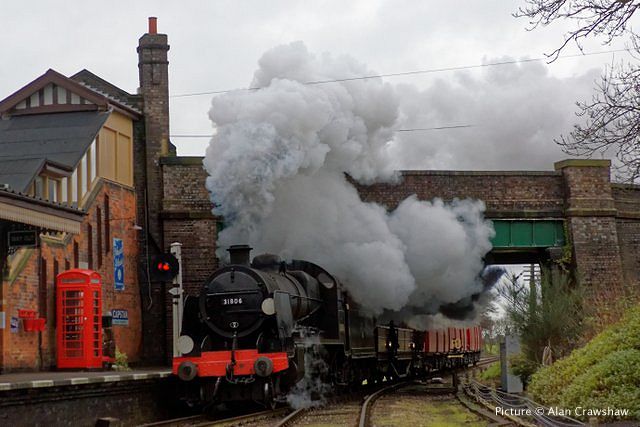
A little later, Southern U class number 31806 stormed through with the demonstration Travelling Post Office (TPO) set. Beyond the station, a crowd was waiting to watch the mailbag collected at speed by the bag catching apparatus. TPO trains ran until January 2004 on the national network, mail being sorted en-route, although use of the 'mailbag apparatus', a favourite of model railway makers, ended in 1971. The locomotive was built at Brighton in 1928, designed for passenger services over the Southern Railway and later served British Railways until 1964.
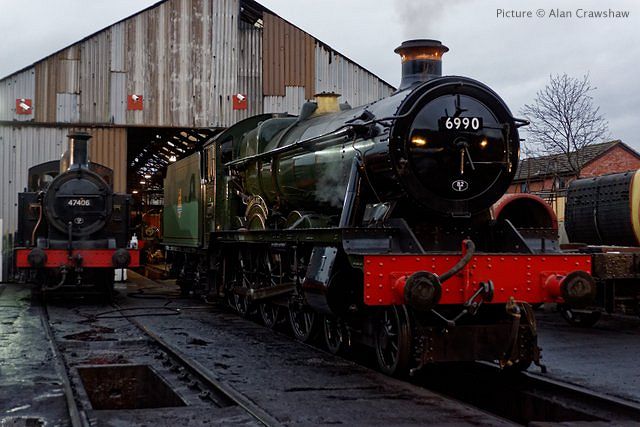
The day finished earlier than Saturday so we returned to Loughborough to watch the twilight activity at the shed as the locomotives returned from terminating services.
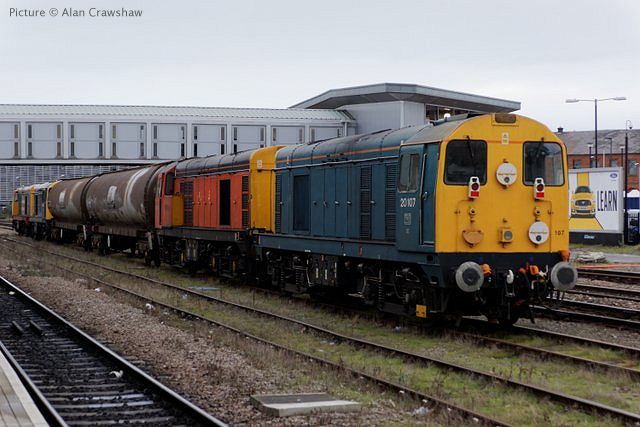
Monday saw us up early for the 08:02 East Midlands Meridian, seven coaches but busy with commuters, couldn't be bothered asking people to move their bags and coats off seats for the short ride to Derby where Rowan and I parted company since I was making a detour to visit relatives. 20 118, 20 096, 20 314 and 20 107 were stabled; this ensemble has been transporting S Stock tube trains from the Old Dalby test track to London, the redundant talk wagons acting as coupling converters.
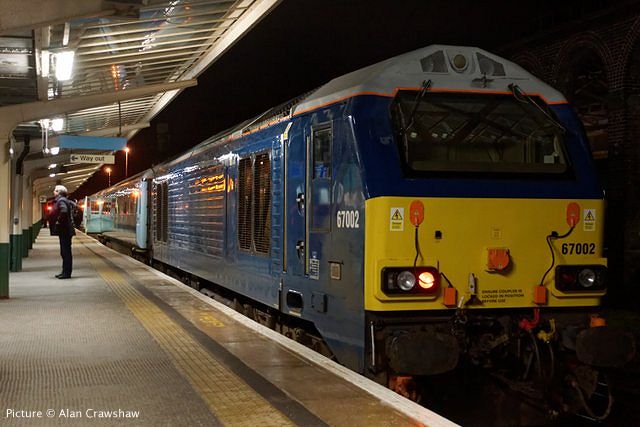
I returned home on Tuesday, the final train being the Arriva Premier service powered by 67 002, which I photographed at both ends of my ride from Chester ...
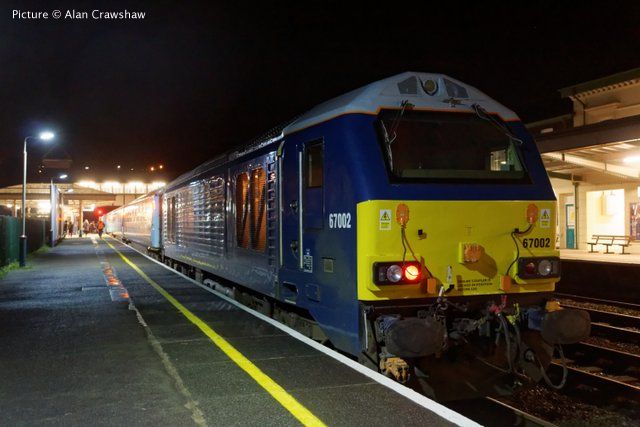
... to Bangor.
Great Central ... and connection woes - report by Stephen Hughes
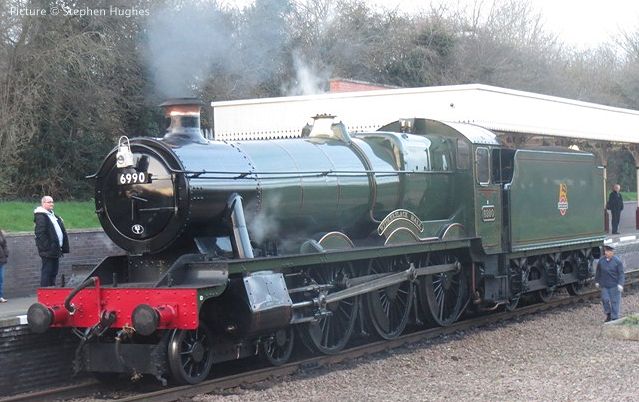
A few weeks ago I decided to visit the Great Central Railway gala, not having been to Loughborough for a number of years. As is my wont these days, I decided to travel by train and found fares and journey times that were acceptable, especially on the return journey. Outward, leaving Bangor at 09:25, I planned to return 12 hours later allowing me to spend nearly five hours on the GCR. The outward journey on Friday 29 January, with changes at Crewe, Derby and Beeston was enjoyable enough as I hadn't been on the Stoke to Derby route since the 1980's. With an on time arrival in Loughborough I walked across town to the GC station, taking just under 20 minutes, helped by the directional signs.
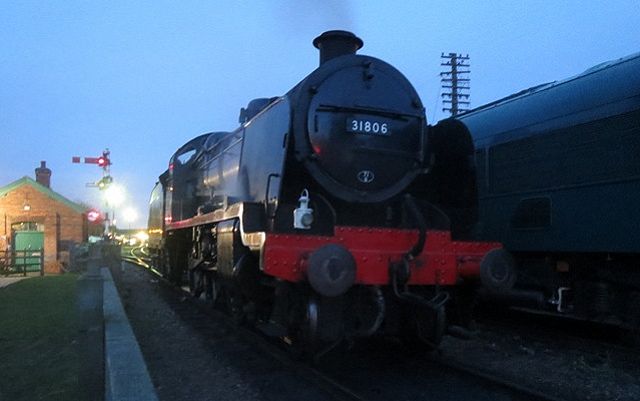
As for the GCR gala, very enjoyable. Five locos in steam on the Friday and not too crowded. As advertised, it does have the feel of main line running due to the double track section and there's a good nostalgia feel. Two highlights for me, deciding to alight at Quorn for a pint in the 'Tin Shed' (Nottingham Brewery) it was surprising (to me, anyway, not to the signalman, I hope!) to witness an 8F roll through with the Windcutters, which really took me back.
Then, having caught the last train back to Loughborough in the gloaming I was able to wander down the track to the shed as the locos were being watered and prepared for the following day. The last time I had wandered (safely) in a shed yard where 7 engines were in steam was probably Nine Elms in 1967!
Additionally, it was the first time that I had seen and taken a photo of 46521 (above) ...
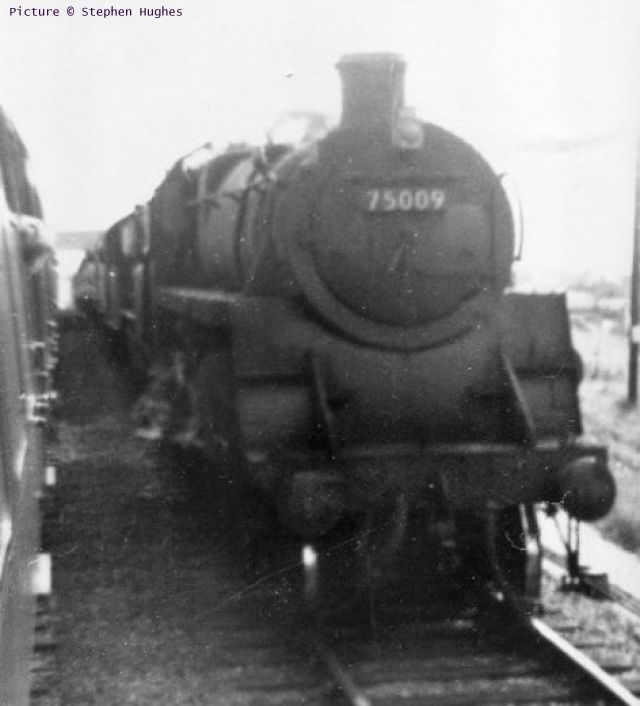
... since 27 Aug 1966 when I spotted it behind 4-6-0 75009 - honest, it is there! - at Tywyn when we were on our way back home from our annual holiday in Pwllheli.
The return was scheduled for a little over three hours, with changes at Leicester and Nuneaton. Although it was a tight connection at Nuneaton (7 minutes) I went for it, as it was advertised.
Alarm bells did start ringing at Leicester on my return when the indicator screen predicted a 5-minute late arrival which led to a 7-minute late departure as there were many people getting on the three car CrossCountry 170. Almost immediately the Conductor-Guard announced that he was aware that there would be a number of passengers who would be wanting a connection at Nuneaton for Crewe, Chester North Wales and Liverpool and that they would ask for the Virgin service to wait a couple of minutes at Nuneaton. I felt reassured and there was some palpable relief on the faces of fellow travellers.
A few minutes later he came back - Virgin would not hold the service and he would pass through the train helping affected passengers with alternative travel arrangements. We arrived in Nuneaton two minutes after the departure of the Virgin to Holyhead.
By now I had resigned myself to staying on to the shopping centre in Birmingham that still had some station platforms [New Street] and eventually hoping to arrive back in Bangor at 23:25 - two hours late. The CrossCountry Conductor-Guard was excellent, I thanked him for his help and he said it happens 'all the time with Virgin'. Ironically, the Virgin train that I picked up at New Street was about 15 minutes late - due to a train fault (no apology) - and when I checked on Real Time Trains the following day the train that didn't wait in Nuneaton arrived in Holyhead 6 minutes early!
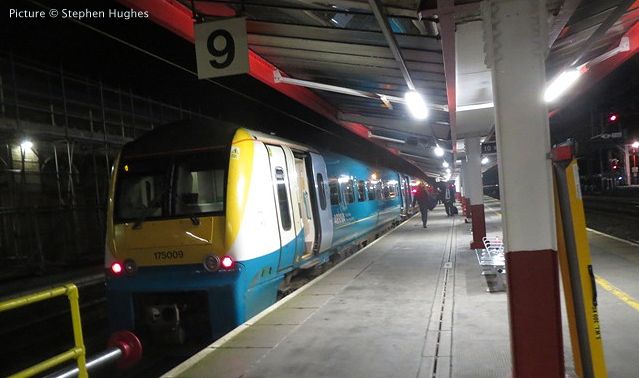
At Crewe I snapped 175 009 because it was a welcome sight at Crewe, especially as I should have already been home!
Now, I am no expert and others might think that on today's railway it is not possible to hold and delay a train for a few minutes, but I would contend that the Trent Valley line was not that busy at that time of the day, and in the case of a connecting train on a Friday evening with a number of students returning home for the weekend it surely is precisely this kind of attitude from Virgin that the average punter is fed up with. Would the connection have been held in the old days?
Perhaps we tend to view something like this through rose-tinted spectacles but I think it probably would have been. After all, it was only a couple of minutes! I'm used to arriving back in Bangor a few minutes late anyway, which I'm quite philosophical about, it's hardly the kind of delay that many have experienced due to the bad weather recently and the early arrival at Holyhead indicates there is some recovery time allowed along the Coast. This was an opportunity for Virgin to gain some plaudits.
More Vale of Rheidol blues - pictures by Barrie Hughes
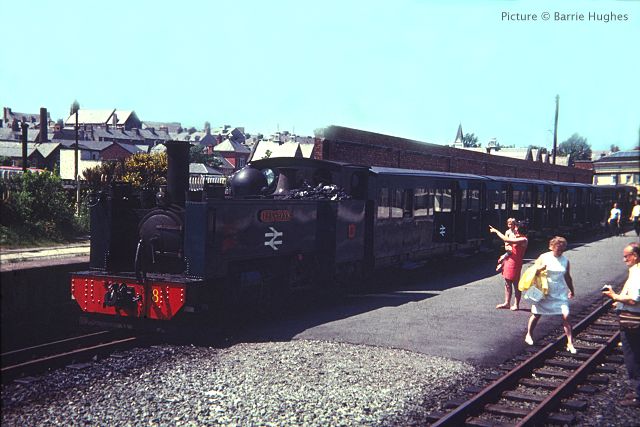
Here are some archive images from May/June 1973 with the Vale of Rheidol Railway trains in BR blue. Above, loco no.8 Llewellyn waits to depart Aberystwyth’s erstwhile Manchester & Milford Railway platform with a mid-day train to Devil’s Bridge.
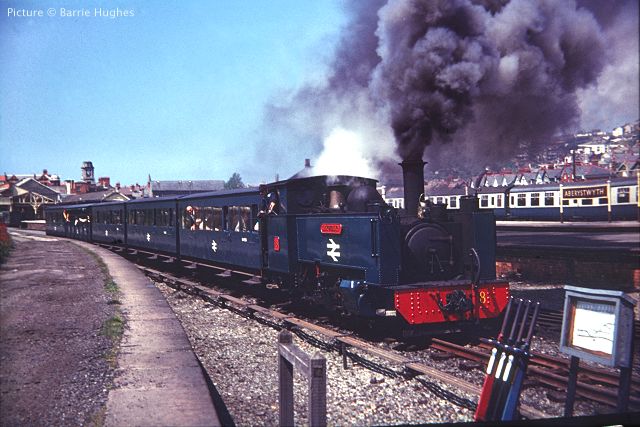
Llewellyn departs from Aberystwyth; the daily loco-hauled 'York Mail' stands in the background.
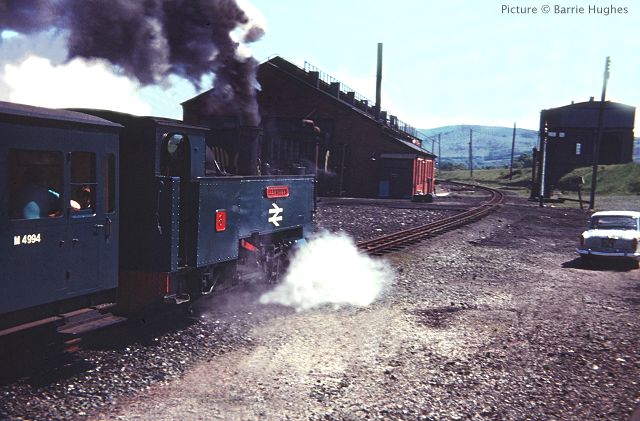
The train heads along the then-new (1969) alignment between the former standard-gauge loco shed and the coaling ramp/water tower.
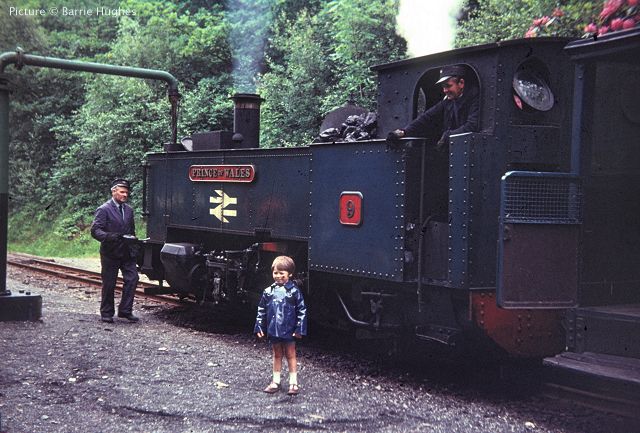
No. 9 Prince of Wales taking water at Aberffrwd.
North Wales Coast home page | Archive | Previous Notice Board